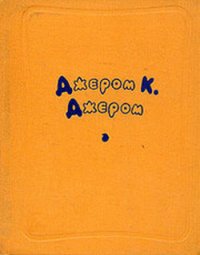Трое в лодке, не считая собаки / Three Men in a Boat (to Say Nothing of the Dog) - Джером Клапка Джером (читать полные книги онлайн бесплатно TXT) 📗
Years later, to the crash of battle-music, Saxon kings and Saxon revelry were buried side by side, and Kingston’s greatness passed away for a time, to rise once more when Hampton Court became the palace of the Tudors and the Stuarts, and the royal barges strained at their moorings on the river’s bank, and bright-cloaked gallants swaggered down the water-steps to cry: “What Ferry, ho! Gadzooks, gramercy [25].”
Many of the old houses, round about, speak very plainly of those days when Kingston was a royal borough, and nobles and courtiers lived there, near their King, and the long road to the palace gates was gay all day with clanking steel and prancing palfreys, and rustling silks and velvets, and fair faces. The large and spacious houses, with their oriel, latticed windows, their huge fireplaces, and their gabled roofs, breathe of the days of hose and doublet, of pearl-embroidered stomachers, and complicated oaths. They were upraised in the days “when men knew how to build.” The hard red bricks have only grown more firmly set with time, and their oak stairs do not creak and grunt when you try to go down them quietly.
Speaking of oak staircases reminds me that there is a magnificent carved oak staircase in one of the houses in Kingston. It is a shop now, in the market-place, but it was evidently once the mansion of some great personage. A friend of mine, who lives at Kingston, went in there to buy a hat one day, and, in a thoughtless moment, put his hand in his pocket and paid for it then and there.
The shopman (he knows my friend) was naturally a little staggered at first; but, quickly recovering himself, and feeling that something ought to be done to encourage this sort of thing, asked our hero if he would like to see some fine old carved oak. My friend said he would, and the shopman, thereupon, took him through the shop, and up the staircase of the house. The balusters were a superb piece of workmanship, and the wall all the way up was oak-panelled, with carving that would have done credit to a palace.
From the stairs, they went into the drawing-room, which was a large, bright room, decorated with a somewhat startling though cheerful paper of a blue ground. There was nothing, however, remarkable about the apartment, and my friend wondered why he had been brought there. The proprietor went up to the paper, and tapped it. It gave forth a wooden sound.
“Oak,” he explained. “All carved oak, right up to the ceiling, just the same as you saw on the staircase.”
“But, great Caesar! man,” expostulated my friend; “you don’t mean to say you have covered over carved oak with blue wall-paper?”
“Yes,” was the reply: “it was expensive work. Had to match-board it all over first, of course. But the room looks cheerful now. It was awful gloomy before.”
I can’t say I altogether blame the man (which is doubtless a great relief to his mind). From his point of view, which would be that of the average householder, desiring to take life as lightly as possible, and not that of the old-curiosity-shop maniac, there is reason on his side. Carved oak is very pleasant to look at, and to have a little of, but it is no doubt somewhat depressing to live in, for those whose fancy does not lie that way. It would be like living in a church.
No, what was sad in his case was that he, who didn’t care for carved oak, should have his drawing-room panelled with it, while people who do care for it have to pay enormous prices to get it. It seems to be the rule of this world. Each person has what he doesn’t want, and other people have what he does want.
Married men have wives, and don’t seem to want them; and young single fellows cry out that they can’t get them. Poor people who can hardly keep themselves have eight hearty children. Rich old couples, with no one to leave their money to, die childless.
Конец ознакомительного фрагмента.
Текст предоставлен ООО «ЛитРес».
Прочитайте эту книгу целиком, купив полную легальную версию на ЛитРес.
Безопасно оплатить книгу можно банковской картой Visa, MasterCard, Maestro, со счета мобильного телефона, с платежного терминала, в салоне МТС или Связной, через PayPal, WebMoney, Яндекс.Деньги, QIWI Кошелек, бонусными картами или другим удобным Вам способом.
Many of the old houses, round about, speak very plainly of those days when Kingston was a royal borough, and nobles and courtiers lived there, near their King, and the long road to the palace gates was gay all day with clanking steel and prancing palfreys, and rustling silks and velvets, and fair faces. The large and spacious houses, with their oriel, latticed windows, their huge fireplaces, and their gabled roofs, breathe of the days of hose and doublet, of pearl-embroidered stomachers, and complicated oaths. They were upraised in the days “when men knew how to build.” The hard red bricks have only grown more firmly set with time, and their oak stairs do not creak and grunt when you try to go down them quietly.
Speaking of oak staircases reminds me that there is a magnificent carved oak staircase in one of the houses in Kingston. It is a shop now, in the market-place, but it was evidently once the mansion of some great personage. A friend of mine, who lives at Kingston, went in there to buy a hat one day, and, in a thoughtless moment, put his hand in his pocket and paid for it then and there.
The shopman (he knows my friend) was naturally a little staggered at first; but, quickly recovering himself, and feeling that something ought to be done to encourage this sort of thing, asked our hero if he would like to see some fine old carved oak. My friend said he would, and the shopman, thereupon, took him through the shop, and up the staircase of the house. The balusters were a superb piece of workmanship, and the wall all the way up was oak-panelled, with carving that would have done credit to a palace.
From the stairs, they went into the drawing-room, which was a large, bright room, decorated with a somewhat startling though cheerful paper of a blue ground. There was nothing, however, remarkable about the apartment, and my friend wondered why he had been brought there. The proprietor went up to the paper, and tapped it. It gave forth a wooden sound.
“Oak,” he explained. “All carved oak, right up to the ceiling, just the same as you saw on the staircase.”
“But, great Caesar! man,” expostulated my friend; “you don’t mean to say you have covered over carved oak with blue wall-paper?”
“Yes,” was the reply: “it was expensive work. Had to match-board it all over first, of course. But the room looks cheerful now. It was awful gloomy before.”
I can’t say I altogether blame the man (which is doubtless a great relief to his mind). From his point of view, which would be that of the average householder, desiring to take life as lightly as possible, and not that of the old-curiosity-shop maniac, there is reason on his side. Carved oak is very pleasant to look at, and to have a little of, but it is no doubt somewhat depressing to live in, for those whose fancy does not lie that way. It would be like living in a church.
No, what was sad in his case was that he, who didn’t care for carved oak, should have his drawing-room panelled with it, while people who do care for it have to pay enormous prices to get it. It seems to be the rule of this world. Each person has what he doesn’t want, and other people have what he does want.
Married men have wives, and don’t seem to want them; and young single fellows cry out that they can’t get them. Poor people who can hardly keep themselves have eight hearty children. Rich old couples, with no one to leave their money to, die childless.
Конец ознакомительного фрагмента.
Текст предоставлен ООО «ЛитРес».
Прочитайте эту книгу целиком, Купить полную версию книги




